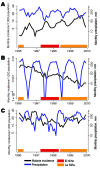Links between climate, malaria, and wetlands in the Amazon Basin
- PMID: 19331766
- PMCID: PMC2671454
- DOI: 10.3201/eid1504.080822
Links between climate, malaria, and wetlands in the Amazon Basin
Abstract
Climate changes are altering patterns of temperature and precipitation, potentially affecting regions of malaria transmission. We show that areas of the Amazon Basin with few wetlands show a variable relationship between precipitation and malaria, while areas with extensive wetlands show a negative relationship with malaria incidence.
Figures


References
-
- Millennium Ecosystem Assessment. Ecosystems and human well-being: synthesis. Washington: Island Press; 2005.
-
- Gil LH, Tada MS, Katsuragawa TH, Ribolla PE, da Silva LH. Urban and suburban malaria in Rondonia (Brazilian Western Amazon) II. Perennial transmissions with high anopheline densities are associated with human environmental changes. Mem Inst Oswaldo Cruz. 2007;102:271–6. 10.1590/S0074-02762007005000013 - DOI - PubMed
Publication types
MeSH terms
LinkOut - more resources
Full Text Sources
Medical
